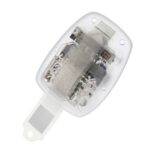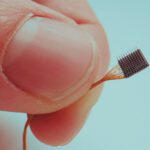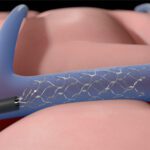
Synchron co-founder and CEO Dr. Thomas Oxley [Photo courtesy of Synchron]
Synchron is one of those BCI developers, and in an interview with Synchron co-founder and CEO Dr. Tom Oxley, we asked him to explain some BCI basics. (Look for much more from our conversation in Medical Design & Outsourcing‘s January 2024 Leadership issue.)
What is a brain-computer interface (BCI)?
“It’s pretty universally accepted that a definition of a BCI is a direct connection to the brain with an external device that enables transfer of information from the brain,” Oxley said.
But it’s important to understand that definition of a BCI is not enough when it comes to medical device regulatory approval and reimbursement, he said: “It has to do something meaningful.”
The FDA is using neuroprosthesis as a synonym for a BCI medical device. A neuroprosthesis goes further than a BCI in that it restores a lost nervous function. Cochlear implants for hearing are examples of neuroprosthesis BCIs that are already on the market.
“The difference between a [medical] BCI and a neuroprosthesis is that the BCI has to restore a lost brain function, and you don’t necessarily achieve that with a traditional BCI definition, which is just a connection from the brain to the outside world,” Oxley said. “I think that’s a very important distinction to make, because that piece has been missing as we contemplate how to assess the efficacy of a brain-computer interface in the clinical medical device world?”
The basic BCI components
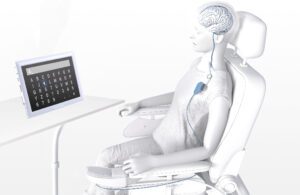
Synchron’s brain-computer interface (BCI) system uses the Stentrode brain implant to sense brain signals and relay them to a receiver implant in a patient’s chest. [Illustration courtesy of Synchron]
“There’s the implant that senses brain activity,” he said. “There’s the transmission of data, which hopefully is wireless, but up to up until now has not been wireless — it’s been a cable coming out of the skull.”
After sensing and transmission, he said, there’s output.
“Output is the interaction with a computer that does some task,” he said. “And then you could argue task is the fourth piece.”
A BCI system must also analyze the brain signals that it’s sensing to translate or interpret them. Synchron is building a dictionary of brain signals and their corresponding actions.
Synchron developed a catheter-placed brain implant, the Stentrode, which senses neural signals from inside a blood vessel in the brain and relays them to a receiver implanted in the patient’s chest. The receiver transmits those brain signals to a decoder, and then the signals are translated into digital commands.
Related: Catheter delivery could enable better brain implants: Synchron’s neuroscience chief explains how
BCI misconceptions
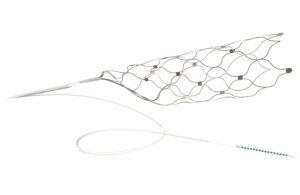
The Synchron Stentrode brain implant expands inside a blood vessel, placing its electrodes against the vessel wall to sense brain signals. [Image courtesy of Synchron]
“What we’re focused on is building a control language that can lead to control of a range of things, which may include an arm or a leg or exoskeleton or prosthesis, but actually, in the first instance, is controlling smart devices — iPhones,” he said.
“Reanimating an arm or creating a robotic limb just for the purpose of clicking on a screen is overengineering a problem,” he continued. “The way we’re thinking about it is let’s build a simplified control sequence from the brain [to] restore the control of the digital ecosystem for people whose muscles don’t work. That’s powerful.”
Another misconception, he said, is that BCI technology developers want to merge humans with computers.
“There’s this dystopian misconception around where BCI is headed, when the reality is BCI is restoring function and lost independence to people with disability,” he said.
Medtech glossary: Medical device industry terms, abbreviations and acronyms



